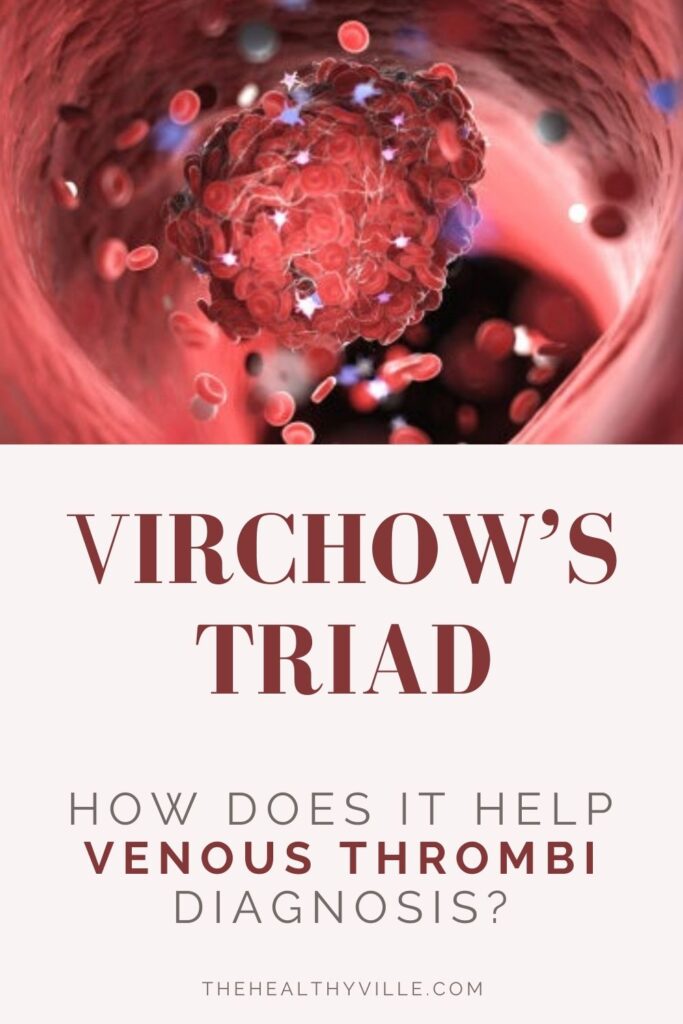Virchow’s triad is a medical terminology that brings together three factors that affect coagulation and thrombus formation. The worst consequence is venous thromboembolism.
Virchow’s triad is a series of 3 changes that occur inside the veins, and that determine the formation of venous thrombi. The situation is also known as venous thromoboembolism.
This triad was described by a German pathologist named Rudolf Virchow, more than 150 years ago. He described, for the first time, the conditions necessary for venous thrombi to form and spread.
We will begin by describing the Virchow’s triad, and then several definitions that will allow us to understand venous thrombosis and its health risks.
What does Virchow’s triad comprise of?
Virchow’s triad includes three changes:
- Blood flow abnormalities.
- Hypercoagulability: a state that causes the formation of venous clots or thrombi.
- Endothelial damage: they are injuries to the interior of the blood vessels.
There are the states that lead to the appearance of the triad. Once the factors are attached, platelets accumulate as traps that retain neutrophils. Platelets, together with neutrophils, will form venous thrombi and lead to the disease thromboembolism.
Prothrombotic states: what are they?
Prothrombotic states are situations, hereditary or acquired, in which Virchow’s triad has a good chance of appearing. They are consisting of modifiable and non-modifiable risk factors.
An example which can lead to a prothrombotic state are genetic mutations. This inheritance is difficult or impossible to modify, since the baby acquires the risk factor at the moment of conception.
On the other hand, there are systemic diseases that stimulate blood clotting, such as cancer, high blood pressure, kidney disease, and chronic venous disease. Particularly susceptible are persons with varicose veins and venous insufficiency.
Habits and lifestyle are not minor in the thrombus equation. Obese people and those who smoke are at high risk. Those who must travel for long periods by plane, immobile, can stimulate clotting in their legs.
For women, special attention deserves the use of estrogens in hormonal contraceptives. A doctor should always assess the risk of thrombosis, before indicating contraception of this type. And during pregnancy, the pressure of the uterus on the veins that go to the lower limbs, slows down circulation, also favoring Virchow’s triad.
Other associated situations are:
- Chronic obstructive lung disease.
- Air pollution.
- Trauma to the lower limbs.
- Prolonged immobilization for hospitalizations longer than 48 hours.
What is venous thromoboembolism?
There are two venous thromboembolism entities that can cause death or vascular disability. In fact, they are the most common preventable cause of death in hospitalized people:
- DVT or deep vein thrombosis
- Pulmonary thromboembolism
Venous thrombi can remain in their formation site or break away from where they formed to travel through the bloodstream. If detachment occurs, they will transform into emboli, which if they reach the heart pass into the pulmonary circulation.
Lower limb thrombosis is the most common. It occurs with redness in the area, hypersensitivity to touch, local heat, cramps and pain.
If a thrombus forms and pulmonary embolism develops, symptoms are shortness of breath, syncope or fainting, hypotension, and cyanosis (bluish discoloration of the skin). The consequence is fatal without timely and adequate treatment.
How are Virchow’s triad problems diagnosed?
The usual way in which doctors make the diagnosis of deep vein thrombosis is through Doppler ultrasound of the deep venous system. In fact, the sonographer examines the presence of obstructions in the flow of blood or assesses the loss of compressibility of the veins.
In cases difficult to diagnose, or doubtful cases, doctors will perform a CT or nuclear magnetic resonance imaging of the suspicious limb.
For pulmonary thromboembolism, the main diagnostic method will be pulmonary CT. Sometimes doctors prefer a diagnostic test, a lung scan.
Why is it so important?
Since today, we know more about blood coagulation and Virchow’s triad, there’s a decrease in cases of hospitalizations for thrombi and emboli. However, we can prevent even more deaths from these causes.
Therefore, leading healthy lifestyle habits and taking care of our extremities is essential to reduce the risk of hypercoagulation within the blood circulation. Consult a doctor if you have questions about the steps you can take to protect yourself.
Don’t forget to SHARE everything you learned about this topic with your friends and family on your social networks!

